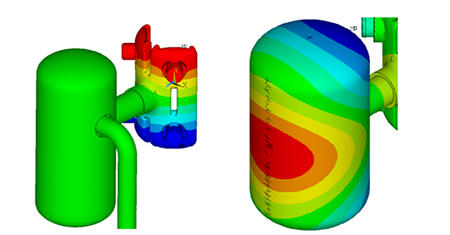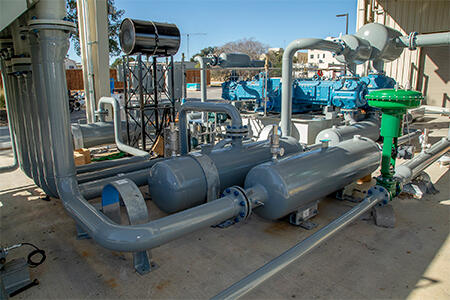Compressors and pumps used in pipelines and piping systems can cause pulsations and vibrations that lead to fatigue, failure and structural damage. The American Petroleum Institute’s API 618 and API 688 standards provide guidelines for reciprocating compressor design to address potential pulsation and vibration problems.
Southwest Research Institute has developed a comprehensive approach to analyze API 618 and API 688 compressor pulsation design using field validated best-in-class software for accurate analysis for manufacturers and end users. Our team also contributes to published research and is active on various API committees.
API 618 & API 688 Design Approaches

Analysis of pulsation bottle drawings and designs using TAPS.
SwRI’s design analysis tools include the SwRI-developed Transient Analysis Pulsation Solver (TAPS) and commercially available tools with analysis by engineers with decades of experience and a commitment to helping advance the state of the industry.
Design Approach 1 – This includes preliminary bottle sizing based primarily on empirical formulas. Note that this approach does not include a pulsation simulation and has been removed from API 618 as of the sixth edition and from API 688 as of the second edition.

Reciprocating compressor bottles and flow loop piping system.
Design Approach 2 – This includes full pulsation and pressure drop analysis of the system together with the development of pulsation bottle designs. The mechanical natural frequencies of the individual pipe spans are also calculated (Mechanical Piping Restraint Review) and compared to the frequencies of acoustical and mechanical energy in the system. Modifications to the piping restraints are made, where necessary, to avoid significant coincidence between such frequencies. Deliverables include a final report with a summary of recommendations (including pulsation bottle drawings that can be given to a fabricator for construction), and a summary of calculated results including pulsation levels, pulsation bottle shaking forces, and pressure drops.
Design Approach 3 – This expands on a Design Approach 2 analysis by also including a “Mechanical Compressor Manifold Analysis” using finite element analysis techniques to evaluate the mechanical natural frequencies, mode shapes, and forced response behavior (vibration and dynamic stress) of the compressor manifold system.
Related design services are applicable to systems associated with the following machine types:
- Reciprocating compressors (API 618 and API 688)
- Centrifugal compressors (API 617)
- Screw Compressors (API 619)
- Reciprocating Pumps (API 674)
